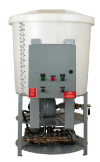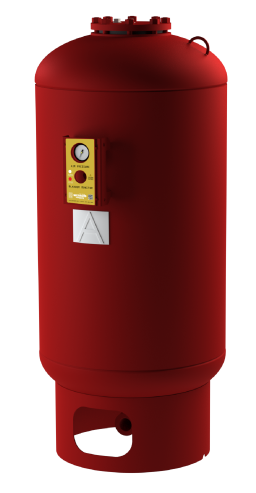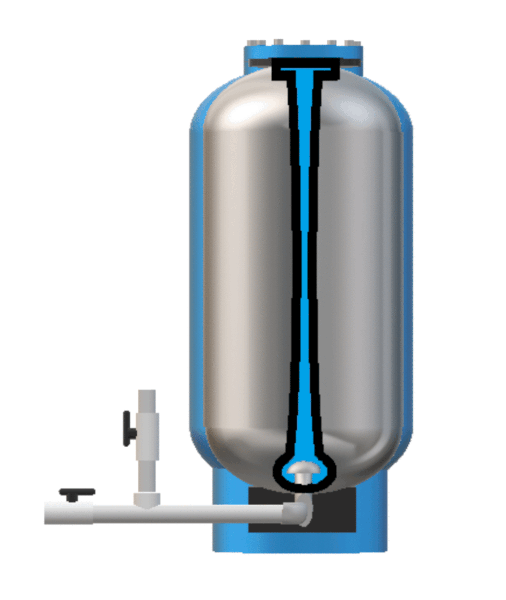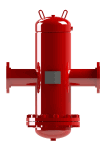Frequently Asked Questions

1. What is causing the GMP low liquid level cut-off alarm to go off?
The GMP probes measure the electrical continuity of the fluid. Premixed glycol/water often uses deionized water, which, along with glycol, have very low conductivity. The sensitivity of the probes can be adjusted by removing the motor starter control cover. Adjust the potentiometer counter-clockwise until the alarm shuts down. An alternate “fix” is to increase the conductivity of the glycol/water mixture by adding 1-2 gallons of tap water to the solution container.
GMP Conductivity Sensor Adjustment
GMP Installation and Operation Manual
2. What is causing the GMP system pressure to build up?
If the pressure continues to increase beyond the PRV setting at startup (or with the system shut down), the pressure reducing valve has dirt or other debris that is holding the valve slightly open. The internals of the PRV can be easily removed and cleaned.
GMP Pressure Reducing Valve Cleaning
3. What is causing the GMP motor/pump to short cycle?
Check the integrity of the small pressure tank (expansion tank) located on the bottom portion of the steel frame and inspect the system for any leaks. Also, check the Pressure Reducing Valve (PRV) for leaks and clean if necessary. Finally, check to make sure the pump vane is not damaged if pressure fails to build up.
4. What is causing the GMP motor/pump to stay on?
The pump is designed to deliver glycol to the bladder tank to 80 psig then shut off. If the pump continues to run, either the glycol is going somewhere else, or the pump is not reaching pressure. A simple test is to isolate the GMP from the system (turn off ball valve to the system).
5. What is causing the GMP solution container to drain rapidly upon start-up?
The small pressure tank (expansion tank) pre-charge may be set incorrectly and need to be reset. The pump is designed to deliver glycol to the bladder tank to 80 PSIG then shut off. If the pump continues to run, and the glycol level in the solution container continues to drop, the glycol is going somewhere else. The glycol is being pushed into the system. The likely “culprit” is the system expansion tank. If the system expansion tank is set for a lower pressure (say 12 PSIG) and the GMP pressure regulator (PRV) is set to a higher pressure (say 20 PSIG), the pump will continue to run, pushing fluid into the system expansion tank. Isolate the GMP from the system (turn off ball valve to the system). The system expansion tank pre-charge pressure (with no fluid in the tank) must be set to equal the GMP pressure reducing valve setting. This means all the fluid from the system expansion tank must be drained prior to adjusting the tank’s pre-charge pressure.
6. Can the GMP be installed outside?
Although the GMP has a skirt to protect against large contaminants, the electrical components must be protected from elements like rain and snow, so a shed or protective structure must be built around the GMP if it is installed outside.
7. How do I check and set my tank pre-charge?
 All Wessels expansion tanks come factory pre-charged to 12, 30, or 40 PSIG depending on the model, but this may not be the correct setting for your installation. Check the included pressure guage or remove the pipe plug covering the air valve and attach a pressure gauge if one is not included. To set the pre-charge, the tank must be isolated from the system and emptied. Release air to decrease pressure or add compressed air (oil and water-free) or nitrogen to reach your installation’s design fill pressure.
All Wessels expansion tanks come factory pre-charged to 12, 30, or 40 PSIG depending on the model, but this may not be the correct setting for your installation. Check the included pressure guage or remove the pipe plug covering the air valve and attach a pressure gauge if one is not included. To set the pre-charge, the tank must be isolated from the system and emptied. Release air to decrease pressure or add compressed air (oil and water-free) or nitrogen to reach your installation’s design fill pressure.
Expansion Tank Start Up Instructions
8. Where is the water in an expansion tank?
In diaphragm and bladder expansion tanks,  system water is inside a butyl rubber bladder and separated from a cushion of pre-charged air inside the tank. In diaphragm tanks, the bladder is fixed and cannot be removed. In bladder tanks, the bladder is removable and replaceable. In compression tanks, the water is inside the tank and there is no butyl bladder barrier between the air and the water. The pressure of the air cushion can be read on the included pressure gauge on diaphragm and bladder tanks or measured and set from the schrader air valve.
system water is inside a butyl rubber bladder and separated from a cushion of pre-charged air inside the tank. In diaphragm tanks, the bladder is fixed and cannot be removed. In bladder tanks, the bladder is removable and replaceable. In compression tanks, the water is inside the tank and there is no butyl bladder barrier between the air and the water. The pressure of the air cushion can be read on the included pressure gauge on diaphragm and bladder tanks or measured and set from the schrader air valve.
9. How can I tell if my tank bladder has failed?
Has your WessView® Bladder Monitor turned red or has your WessGuard® Bladder Integrity Monitor sounded an audible alarm? Press the schrader air valve release. If water comes out of the air charge valve, the bladder must be replaced. If water does not come out of the air valve, isolate and drain your tank. Set the pre-charge and check if you are losing pressure out through the waterline. If you discover air escaping through the waterline, replace bladder.
10. Why is my WessView® pink, yellow, or brown?
The WessView® is a color changing sight glass. The design uses a desiccant (scientific grade salt) that sits on top of a red disk. If the desiccant touches water and dissolves, the bright red disk will start to show. If the tank is charged with an air compressor in the field, the desiccant can turn pink, yellow, or brown if the air is moist or contaminated with oil.
11. Why won’t my tank hold its pre-charge?
You may be experiencing an air leak. Isolate and drain the tank and then pre-charge the tank to system pressure using the air charge valve. Apply a soap/water solution around the air charge valve, the space between the top cover and tank head, all plugged tappings, along all of the weld seams, and on the bottom head at the system connection. Bubbles will indicate if the air leak is caused by an improper seal or weld. If there are no bubbles and the tank still does not hold an air charge, please review question #7 above.
12. How do I pressurize a high air charge (typically over 80 psig)?
The expansion tank design incorporates an anti-extrusion screen. Its function is to hold back the bladder from extruding out the tank as air or nitrogen is added to reach the required minimum pressure. Without water to push against, the air charge can push the bladder through the anti-extrusion screen at elevated air charge pressures (typically well over 80 psig). The result can be a failed bladder during startup. To guard against this potential issue, a small amount of water can be placed inside the bladder (by opening the system valve momentarily). This incompressible water acts with the anti-extrusion screen to stop any occurrence of this type of potential.
13. What happens if my tank is undersized?
An undersized tank can result in a large pressure swing from start up to operating stages. High water storage will lead to the bladder rubbing against the tank wall with each cycle. The bladder could wear due to the higher water volumes.
14. How do I replace my tank bladder?
For detailed instructions on how to remove and replace your tank’s bladder, please click the links below or watch the short instructional video Wessels Expansion Tank Bladder Installation.
NLA Large Bladder Replacement Instructions
FXA Large Bladder Replacement Instructions
15. What types of fluids can I store in my bladder tank?
Bladder tanks are typically used for hydronic (water) applications or water-glycol mixtures. For other fluid compatibilities, please contact us.
16. Can the bladder handle extreme temperatures?
The butyl bladder is rated for 240°F intermittent temperature. The temperature of the fluid in the bladder is typically a meld of the temperature from startup to operating temperatures. A proper heat trap should arrest thermally migrating hot water from continuing to circulate and overheat the fluid in the tank, and the tank should approach ambient temperature of the equipment room. If not equipped with fluid side thermal isolation, the fluid can continually heat to the point of equaling the operating temperature. The closer to 240oF, the lower the life expectancy of the bladder.
17. What is tank draw-down?
Tank draw-down volume is the amount of water (typically in gallons) that is stored between a high and low pressure, usually set by a pump switch. Tank draw-down is also called Acceptance volume, which is the volume of water in a tank and is sometimes expressed as a multiplier against tank volume called an acceptance factor. Tank volume is the overall tank volume including air and water.
18. Does the flow orientation for the WVA matter?
The WVA is designed to be omnidirectional so the inlets and outlets can be swapped without affecting performance.
19. What size tanks does Wessels manufacture?
Wessels Company manufactures tanks up to 144 inches in diameter and 50 feet long.
20. Are Wessels tanks UL listed?
Tanks can be manufactured to UL requirements, but are not UL listed.
21. Are Wessels tanks NSF61 certified?
Wessels Company manufactures with NSF61 listed materials including stainless steel and NSF61 certified Butyl bladders. All wetted parts conform to and are listed NSF61.
22. What is ASME Specification?
 The American Society of Mechanical Engineers (ASME) is a professional standards organization that sets technical guidelines for mechanical manufacturers, engineers, designers, and equipment operators. Wessels Company is proud to be an ASME certified manufacturer of pressure vessels and custom tanks.
The American Society of Mechanical Engineers (ASME) is a professional standards organization that sets technical guidelines for mechanical manufacturers, engineers, designers, and equipment operators. Wessels Company is proud to be an ASME certified manufacturer of pressure vessels and custom tanks.
